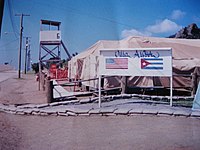| Part of the Cuban exodus | |
 Housing for refugees at Guantanamo Bay | |
| Date | 15 April – 31 October 1994 (5 months, 2 weeks and 2 days) |
|---|---|
| Participants | |
| Outcome | Around 35,000 Cubans arrive in the United States |
The 1994 Cuban rafter crisis which is also known as the 1994 Cuban raft exodus or the Balsero crisis was the emigration of more than 35,069 Cubans to the United States (via makeshift rafts). [1] The exodus occurred over five weeks following rioting in Cuba; Fidel Castro announced in response that anyone who wished to leave the country could do so without any hindrance. [1] Fearing a major exodus, the Clinton administration would mandate that all rafters captured at sea be detained at the Guantanamo Bay Naval Base. [2]